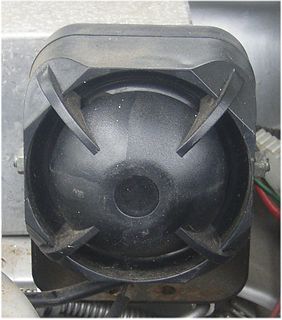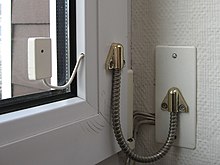
A smoke detector is a device that senses smoke, typically as an indicator of fire. Smoke detectors are usually housed in plastic enclosures, typically shaped like a disk about 150 millimetres (6 in) in diameter and 25 millimetres (1 in) thick, but shape and size vary. Smoke can be detected either optically (photoelectric) or by physical process (ionization). Detectors may use one or both sensing methods. Sensitive alarms can be used to detect and deter smoking in banned areas. Smoke detectors in large commercial and industrial buildings are usually connected to a central fire alarm system.

A car alarm is an electronic device installed in a vehicle in an attempt to discourage theft of the vehicle itself, its contents, or both. Car alarms work by emitting high-volume sound when the conditions necessary for triggering it are met. Such alarms may also cause the vehicle's headlights to flash, may notify the car's owner of the incident via a paging system, and may interrupt one or more electrical circuits necessary for the car to start. Although inexpensive to acquire and install, the effectiveness of such devices in deterring vehicle burglary or theft when their only effect is to emit sound appears to be negligible.
Motion detection is the process of detecting a change in the position of an object relative to its surroundings or a change in the surroundings relative to an object. It can be achieved by either mechanical or electronic methods. When it is done by natural organisms, it is called motion perception.

A security alarm is a system designed to detect intrusion, such as unauthorized entry, into a building or other areas such as a home or school. Security alarms used in residential, commercial, industrial, and military properties protect against burglary (theft) or property damage, as well as personal protection against intruders. Security alerts in neighborhoods show a connection with diminished robbery. Car alarms likewise help protect vehicles and their contents. Prisons also use security systems for the control of inmates.

A fire alarm control panel (FACP), fire alarm control unit (FACU), fire indicator panel (FIP), or simply fire alarm panel is the controlling component of a fire alarm system. The panel receives information from devices designed to detect and report fires, monitors their operational integrity and provides for automatic control of equipment, and transmission of information necessary to prepare the facility for fire based on a predetermined sequence. The panel may also supply electrical energy to operate any associated initiating device, notification appliance, control, transmitter, or relay. There are four basic types of panels: coded panels, conventional panels, addressable panels, and multiplex systems.
A false alarm, also called a nuisance alarm, is the deceptive or erroneous report of an emergency, causing unnecessary panic and/or bringing resources to a place where they are not needed. False alarms may occur with residential burglary alarms, smoke detectors, industrial alarms, and in signal detection theory. False alarms have the potential to divert emergency responders away from legitimate emergencies, which could ultimately lead to loss of life. In some cases, repeated false alarms in a certain area may cause occupants to develop alarm fatigue and to start ignoring most alarms, knowing that each time it will probably be false. The activation of false alarms in businesses and schools can lead to serious disciplinary actions, and criminal penalties such as fines and jail time.

A passive infrared sensor is an electronic sensor that measures infrared (IR) light radiating from objects in its field of view. They are most often used in PIR-based motion detectors. PIR sensors are commonly used in security alarms and automatic lighting applications.

Manual fire alarm activation is typically achieved through the use of a pull station or call point, which then sounds the evacuation alarm for the relevant building or zone. Manual fire alarm activation requires human intervention, as distinct from automatic fire alarm activation such as that provided through the use of heat detectors and smoke detectors. It is, however, possible for call points/pull stations to be used in conjunction with automatic detection as part of the overall fire detection and alarm system. Systems in completed buildings tend to be wired in and include a control panel. Systems for use during construction can also be wireless or mechanical, it is recommended by the Structural Timber Association in the UK that for timber-framed constructions, interconnecting wireless systems be used.

A carbon monoxide detector or CO detector is a device that detects the presence of the carbon monoxide (CO) gas to prevent carbon monoxide poisoning. In the late 1990s Underwriters Laboratories changed the definition of a single station CO detector with a sound device to carbon monoxide (CO) alarm. This applies to all CO safety alarms that meet UL 2034 standard; however for passive indicators and system devices that meet UL 2075, UL refers to these as carbon monoxide detectors.

A motion detector is an electrical device that utilizes a sensor to detect nearby motion. Such a device is often integrated as a component of a system that automatically performs a task or alerts a user of motion in an area. They form a vital component of security, automated lighting control, home control, energy efficiency, and other useful systems.

Home security includes both the security hardware placed on a property and individuals' personal security practices. Security hardware includes doors, locks, alarm systems, lighting, motion detectors, and security camera systems. Personal security involves practices like ensuring doors are locked, alarms are activated, owning a Dog, windows are closed, and extra keys are not hidden outside.

A fire alarm system warns people when smoke, fire, carbon monoxide or other fire-related emergencies are detected. These alarms may be activated automatically from smoke detectors and heat detectors or may also be activated via manual fire alarm activation devices such as manual call points or pull stations. Alarms can be either motorized bells or wall mountable sounders or horns. They can also be speaker strobes which sound an alarm, followed by a voice evacuation message which warns people inside the building not to use the elevators. Fire alarm sounders can be set to certain frequencies and different tones including low, medium, and high, depending on the country and manufacturer of the device. Most fire alarm systems in Europe sound like a siren with alternating frequencies. Fire alarm electronic devices are known as horns in the United States and Canada and can be either continuous or set to different codes. Fire alarm warning devices can also be set to different volume levels.

A gunfire locator or gunshot detection system is a system that detects and conveys the location of gunfire or other weapon fire using acoustic, vibration, optical, or potentially other types of sensors, as well as a combination of such sensors. These systems are used by law enforcement, security, military, government offices, schools and businesses to identify the source and, in some cases, the direction of gunfire and/or the type of weapon fired. Most systems possess three main components:
A medical alarm is an alarm system designed to signal the presence of a hazard requiring urgent attention and to summon emergency medical personnel. Other terms for a medical alarm are Personal Emergency Response System (PERS) or medical alert.

Ultrasonic transducers and ultrasonic sensors are devices that generate or sense ultrasound energy. They can be divided into three broad categories: transmitters, receivers and transceivers. Transmitters convert electrical signals into ultrasound, receivers convert ultrasound into electrical signals, and transceivers can both transmit and receive ultrasound.

A gas detector is a device that detects the presence of gases in an area, often as part of a safety system. A gas detector can sound an alarm to operators in the area where the leak is occurring, giving them the opportunity to leave. This type of device is important because there are many gases that can be harmful to organic life, such as humans or animals.
Geophysical MASINT is a branch of Measurement and Signature Intelligence (MASINT) that involves phenomena transmitted through the earth and manmade structures including emitted or reflected sounds, pressure waves, vibrations, and magnetic field or ionosphere disturbances.
A flame detector is a sensor designed to detect and respond to the presence of a flame or fire, allowing flame detection. Responses to a detected flame depend on the installation, but can include sounding an alarm, deactivating a fuel line, and activating a fire suppression system. When used in applications such as industrial furnaces, their role is to provide confirmation that the furnace is working properly; it can be used to turn off the ignition system though in many cases they take no direct action beyond notifying the operator or control system. A flame detector can often respond faster and more accurately than a smoke or heat detector due to the mechanisms it uses to detect the flame.

A train inspection system is one of various systems of inspection which are essential to maintain the safe running of rail transport.














